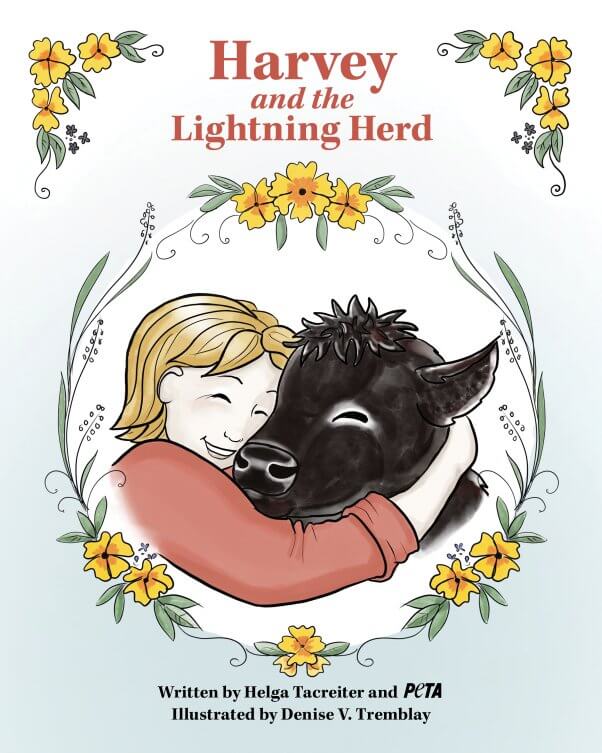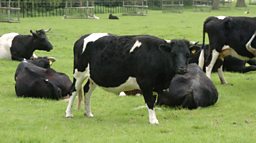October 14, 2024
Bridgeton, N.J. – Available today, Harvey and the Lightning Herd is a new children’s book by Helga Tacreiter and PETA that tells the sweet story of Tacreiter’s friendship with a tiny calf named Harvey and how nursing him back to health—after a disastrous storm left him with a disability—led her to open an animal sanctuary. The book features enchanting illustrations by Denise V. Tremblay and a surprise on the back cover: a QR code that links to “Cow Wow”—an original song by Tony Award–winning composers Lisa Lambert and Greg Morrison that’s chock-full of fun facts about cows that will get kiddos boppin’ to the beat for bovines. Interviews with Tacreiter are available upon request.

Based on a true story, the book describes how Harvey was one of six calves who survived after lightning struck a tree on a farm where Tacreiter worked. She vowed to save all six calves and formed a special bond with Harvey. He became the inspiration for the faux-fur “cowches”—life-size plush likenesses of real cows—that she handcrafted and sold so she could buy an 80-acre farm, now the site of The Cow Sanctuary.
“Helga Tacreiter’s story shows how compassion, determination, and a little creativity can make a huge difference in someone’s life,” says PETA President Ingrid Newkirk. “Harvey and the Lightning Herd is sure to delight young readers and perhaps inspire them to help make the world a kinder place for all animals.”
Tacreiter, who was born in Poland, immigrated to the U.S. with her family as a child. For more than 30 years, she has rescued cows and other animals typically used in the food industry. She has taken in cows rescued during PETA’s cruelty investigations, from closed-down family farms, and from 4-H programs and university agriculture classes after compassionate students saved them from slaughter. Tremblay previously worked in higher education before pursuing her lifelong interest in illustration and graphic storytelling. She went vegan 28 years ago after visiting a farmed-animal sanctuary. Harvey and the Lightning Herd is her first picture book.
Harvey and the Lightning Herd is available on Amazon and at the PETA Shop—the latter will sell a version with a plush cow toy. All profits from the book will go to The Cow Sanctuary.
PETA—whose motto reads, in part, that “animals are not ours to eat or abuse in any other way”—points out that Every Animal Is Someone and offers free Empathy Kits for people who need a lesson in kindness. For more information, please visit PETA.org.
Nine udderly fascinating facts about cows

Cows are complex creatures. They have best friends and worst enemies. They can adore their grandchildren, boss about their sisters, and enjoy having their hair brushed. In fact, they have personalities just as diverse as the people who look after them. At least, that’s the belief of Cotswold farmer Rosamund Young, author of “The Secret Life of Cows” and the subject of On your Farm: How to Read a Cow.
Here are nine moo-ving observations about the grass-grazing quadrupeds that prove there’s more to our bovine buddies than meets the eye.
1. Cows change colour
A calf might be a very different colour to the bull or cow he or she grows up to be. Rosamund Young has witnessed the youngsters’ skin tones altering as they mature: “They do seem to change colour – just like children can be born blonde and then they go a bit darker.”
Fascinatingly, a Holstein cow’s spots are like a fingerprint: no two cows have exactly the same pattern of black and white spots.
2. Cow personalities are as varied as ours
Observing one particularly placid cow, Rosamund states, “They’re all so different… she’s very friendly and very sweet-natured and you can always go and stroke her… she’s obviously happy.” Other cows might be more boisterous. And they can be highly intelligent or slow to understand, vain and proud, considerate, shy or more bossy, and inventive. “I do think they need to be respected as having massive differences – as many differences as us, quite probably,” says Rosamund. She suspects they may have “a whole wide range of emotions.”
Interestingly, the farmer’s observations may be supported by science: In 2009, researchers from the U.S. Department of agriculture announced that they’d successfully mapped the bovine genome, discovering that cattle have around 22,000 genes – and a staggering 80% are shared with humans.
3. Cows always find time for extra-curricular activities
Although much of a cow’s day is spent eating and chewing the cud, they also like to have fun. They find time for a variety of activities such as babysitting, playing hide-and-seek, blackberry-picking, frolicking and socialising.
4. Cows form friendships and bear grudges
Cows are social animals and, if left to roam freely like Rosamund’s cows, will naturally form large herds. Like people, they will make firm friends with some group members, while avoiding others.
The farmer says she sees these relationships forming consistently – she knows which siblings are pals and which have failed to bond. With two calves as a case study she states, if “I see them together a lot then I know it’s a brother and sister who get on; if I see they’re always apart… it’s not a big deal it’s just that it’s nice they can choose – if they have the access – they can choose to get on with someone else if they want to.”
5. Cows need a good night’s sleep
If you think cows sleep standing up, think again! While they might doze off on all fours for a few minutes, they typically sleep and rest lying down – usually leaning forward on their chest and forelegs or lying completely on their sides. They may not actually sleep for that long but, like us, they do need a good kip to feel happy. Rosamund says it’s logical: “If a human being is a bit bad tempered from not getting enough sleep, then why shouldn’t a cow be?”
6. Cows can’t predict the weather
A cow sitting down means inclement weather is on the way, right? Wrong! Folklore would have us believe that a sure sign of imminent rain is the sight of a herd of cows sitting down in a field. In fact, cows lie down for many reasons, for up to 14 hours a day (now that’s milking it!), and there’s no scientific evidence that wet weather is one of them. As the Farmer’s Almanac states, “Cows lying down in a field more often means they’re chewing their cud, rather than preparing for raindrops.”

7. Cows only have one stomach
Most people think that cows have four stomachs, but in fact they have just one – with four separate chambers: the rumen, reticulum, omasum and abomasum. The complex stomach allows the animal to break down tough plant matter that would normally be indigestible.
8. Cows are colour blind
We all know the expression “red rag to a bull”, but in reality the colour red doesn’t make bulls angry – it’s the motion of the cape in bull fighting that causes a bull to charge. Cows are, in fact, red-green colour blind.
9. Cows like to be groomed
Rosamund carries a brush with her when she’s doing her rounds so she can rid her herd of any dirt or matted hair. She says, “Most cows seem to like to be groomed. It’s a therapeutic thing like a lot of people like to be stroked or massaged.” And on top of that, “cows are quite proud, they like being clean.”